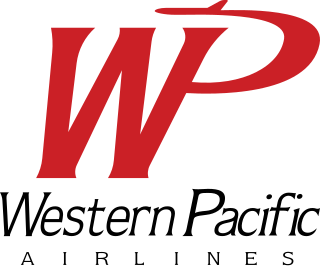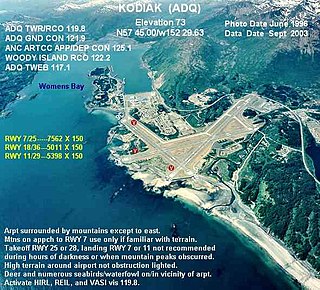Related Research Articles

ATA Airlines, Inc. – formerly known as American Trans Air and commonly referred to as ATA – was an American low-cost scheduled service and charter airline based in Indianapolis, Indiana. ATA operated scheduled passenger flights throughout the U.S. mainland and Hawaii, Puerto Rico, and Portugal as well as military and commercial charter flights around the world. In its early days, the airline flew charters on a worldwide basis and had bases in Chicago, Detroit, New York, Indianapolis, Oakland, and Milwaukee. Later, when it entered scheduled service, the airline maintained focus cities at Chicago Midway International Airport, Honolulu International Airport, and Oakland International Airport.
Alaska Airlines is a major airline in the United States headquartered in SeaTac, Washington, within the Seattle metropolitan area. It is the fifth-largest airline in North America when measured by scheduled passengers carried. Alaska, together with its regional partners Horizon Air and SkyWest Airlines, operates a route network primarily focused on connecting cities along the West Coast of the United States to over 100 destinations in the contiguous United States, Bahamas, Belize, Canada, Costa Rica, Guatemala, and Mexico.

St. Pete–Clearwater International Airport is a public/military airport in Pinellas County, Florida, United States, serving the Tampa Bay Area. It is right on the northeast municipal boundary of Pinellas Park, 9 miles (14 km) north of downtown St. Petersburg, 7 miles (11 km) southeast of Clearwater, and 17 miles (27 km) southwest of Tampa.

Key West International Airport is an international airport located in the City of Key West in Monroe County, Florida, United States, 2 miles east of the main commercial center of Key West.
Panama City–Bay County International Airport(IATA: PFN, ICAO: KPFN, FAA LID: PFN) was a public airport 3 miles (4.8 km) northwest of Panama City, in Bay County, Florida. It was owned and operated by the Panama City–Bay County Airport and Industrial District. All airline services moved to the Northwest Florida Beaches International Airport on May 22, 2010, but the airfield was open to general aviation aircraft until October 1, 2010. The grounds will eventually be turned over to LUK-MB1 LLC, which plans to remove the runways and build homes, shops, walking trails and a marina.

Hooters Air was an airline headquartered in Myrtle Beach, South Carolina, United States. Hooters Air flights were operated by Winston-Salem, North Carolina–based Pace Airlines both as ad hoc private charters, and as scheduled USDOT public charters. As such, flights operated both under Pace Airlines' IATA Code of Y5 for ad hoc charters, and under its own IATA Code of H1 for public charters.

Air Atlanta was an airline based in Atlanta, Georgia, United States, during the mid-1980s, serving over a dozen cities from its hub located at the Hartsfield-Jackson Atlanta International Airport (ATL).

Billings Logan International Airport is in the western United States, two miles northwest of downtown Billings, in Yellowstone County, Montana. It is the fourth largest airport in Montana, having been surpassed in recent years by Bozeman, Missoula, and Flathead County (Kalispell) in both number of gates as well as annual enplanements. Owned by the city of Billings, the airport is on top of the Rims, a 500-foot (150 m) cliff overlooking the downtown core, and covers 2,500 acres of land.

Western Pacific Airlines, or WestPac, was an airline which operated in the United States from 1995 to 1998. A low-cost carrier, it was formed in 1994 under the name Commercial Air, later changed to Western Pacific, and began operating scheduled passenger flights on April 28, 1995, with eight Boeing 737-300s. Edward Gaylord of Gaylord Entertainment Company was involved in the formation and management of the airline. Its headquarters were in unincorporated El Paso County, Colorado, near Colorado Springs.

Combi aircraft in commercial aviation are aircraft that can be used to carry either passengers as an airliner, or cargo as a freighter, and may have a partition in the aircraft cabin to allow both uses at the same time in a mixed passenger/freight combination. The name combi comes from the word combination. The concept originated in railroading with the combine car, a passenger car that contains a separate compartment for mail or baggage.

Juneau International Airport is a city-owned, public-use airport and seaplane base located seven nautical miles northwest of the central business district of Juneau, a city and borough in the U.S. state of Alaska that has no direct road access to the outside world. The airport serves as a regional hub for all air travel, from bush carriers to major U.S. air carriers such as Alaska Airlines.

Daytona Beach International Airport is a county-owned airport located three miles (5 km) southwest of Daytona Beach, next to Daytona International Speedway, in Volusia County, Florida, United States. The airport has 3 runways, a six-gate domestic terminal, and an international terminal. Daytona Beach is the headquarters of Embry-Riddle Aeronautical University.
Vanguard Airlines was a low-cost airline based in Kansas City, Missouri, United States, where it operated a hub from the mid-1990s to the early 2000s. For a time, Vanguard also had significant operations at Chicago Midway International Airport in Chicago, Illinois, until late 2000. It ceased operations on July 29, 2002, after filing for bankruptcy. The airline flew leased Boeing 727-200, 737-200, 737-300 as well as McDonnell Douglas MD-80 series and MD-87 jetliners to a number of destinations from its main hub in Kansas City at the time of its demise. Vanguard Airlines started service in 1994.
MarkAir was a regional airline based in Anchorage, Alaska, that became a national air carrier operating passenger jet service in the United States with a hub and corporate headquarters located in Denver, Colorado. After a second bankruptcy in 1995, it ceased operations in October and was later liquidated.

Kodiak Benny Benson State Airport is a public and military use airport located four nautical miles southwest of the central business district of Kodiak, a city on Kodiak Island in the U.S. state of Alaska. The airport is state-owned and operated by the Alaska Department of Transportation & Public Facilities (DOT&PF). It is home to the co-located Coast Guard Air Station Kodiak and a hub for Servant Air. On April 11, 2013, the Alaska State Legislature passed SB31, which renamed the facility "Kodiak Benny Benson State Airport," in honor of the designer of the Alaskan flag.

Midway Airlines was a United States airline based in Morrisville, North Carolina, between Raleigh and Durham. The airline operated between 1993 and 2003.

Reno Air was a scheduled passenger airline headquartered in Reno, Nevada, United States. Reno Air provided service from its hubs at Reno/Tahoe International Airport in Reno, Nevada, San Jose International Airport in San Jose, California and Las Vegas International Airport in Las Vegas, Nevada to destinations throughout the western United States, including Alaska. International service to Vancouver, British Columbia in western Canada was also served at one point and limited service was operated to the midwestern U.S. as well. A small stand alone operation was also undertaken at one point in the southeastern U.S. with the service being based in Gulfport, Mississippi. American Airlines acquired Reno Air in 1999.

Vision Airlines, formerly Vision Air, was an airline that had its operations headquartered in North Las Vegas, Nevada.

Braniff Inc. was a US-based airline that operated flights from 1984 until 1989 and was partially formed from the assets of the original Braniff International Airways. The domestic air carrier was originally headquartered at Dallas Love Field in Dallas, Texas, and later Orlando, Florida. The airline is sometimes referred to as "Braniff II".

Delta Express was a no-frills "airline within an airline" brand owned and operated by Delta Air Lines from 1996 to 2003. The airline was headquartered in Atlanta, Georgia.
References
- ↑ "Employment." Pro Air. May 23, 1998. Retrieved on September 18, 2009.
- ↑ Perotin, Maria (September 20, 2000). "Discount Carrier Pro Air Grounded". Orlando Sentinel .
- ↑ "FAA Orders Pro Air to Halt Flights". ABC News . September 19, 2000. Retrieved 28 May 2017.
- ↑ "Grounded Pro Air Files For Chapter 11". Travel Weekly. September 20, 2000.
- ↑ "Pro Air Remains Grounded". ABC News. September 28, 2000.
- ↑ Pro Air route map, February 1, 1998.
- ↑ Pro Air route map, February 24, 2000.
- ↑ Pro Air system timetable & route map, February 24, 2000.
- ↑ Pro Air Acquires Aircraft to Launch Pro Air Express; New Service to Feed Jet Flights From Smaller Cities. [ dead link ], PR Newswire, August 25, 1999